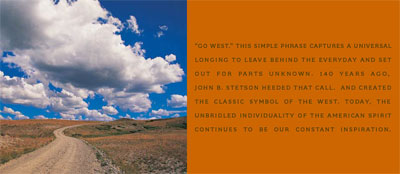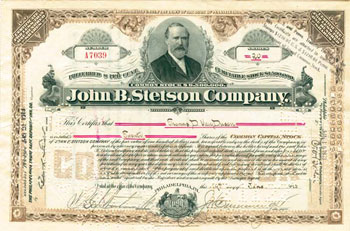A Painter and a Coffin for Two Stetsons
7 October 2007

(Stetson Company)
Anniversary weekend at the Antietam battlefield, Harry Smeltzer came upon the stone honoring Lieutenant Colonel John L Stetson. Stetson was killed at the head of the 59th New York Volunteer Infantry, at the farthest reach of the disastrous Federal Second Army Corps advance into the West Woods on 17 September 1862.
Harry also suggested that Colonel Stetson might have been related to John Batterson Stetson, inventor of a world famous cowboy hat and founder of the company still making them today. Pull this thread, says he …
Before the War John Lemuel Stetson (1834-1862) was a lawyer in Plattsburgh, on Lake Champlain in far northeastern New York State. Among the town’s elite, in 1856 he married the former Lucy Maria Platt, gggranddaughter [tree] of town founder Zephaniah. Sadly, she died in February 1860, just 24 years old. I found no evidence of children.
His father Lemuel was a prominent Democratic lawyer, judge and politician who had served in the US Congress in the mid-1840s. Judge Stetson was proud to be a friend and supporter of the “Little Giant”, Stephen A Douglas.

Lemuel Stetson (1804-1868, Cyclopedia of American Biography)
Lemuel’s lineage, back through his parents Reuben (1775-1838) and Lois Smedley Stetson (1783-1866), runs to Robert Stetson (1613-1702) of Plymouth, Massachusetts, a Cornet in the first “Troop of Horse” in the Colony.
Born in Massachusetts, like his forebears, Reuben was the first Stetson to settle on Lake Champlain in New York, arriving in about 1800. Reuben and Lois had 12 children besides Lemuel, whom they named for Lois’ brother Lemuel Smedley.
His politics notwithstanding, Lemuel was at the forefront of the Union movement in Clinton County when War opened in 1861. With fellow Plattsburgh lawyer, Republican George William Palmer (1818-1916) he chaired patriotic meetings in Plattsburgh on the 17th and 20th of April, 1861, to respond to the President’s call for troops.
At the time designated [on the 17th], the court room was filled by men representing all political parties. Judge Lemuel Stetson, who had been a delegate from the district to the Democratic Convention which met in Charleston, South Carolina, and later at Baltimore, Maryland, in 1860, was called to preside.
On taking the chair, he said: “In this crisis all party feeling should be put aside, and every one stand for the preservation of the Union and with the Administration in enforcing the laws and recovering the property of the United States unlawfully seized.” Several others spoke in the same strain…
… A second meeting was held in the Court House on April 20th. William Palmer was called to the chair … Captain Franklin Palmer and John L. Stetson were chosen secretaries; Thomas Armstrong, Daniel S. McMasters, Henry S. Johnson, George M. Beckwith, John L. Stetson, and Judge Lemuel Stetson, addressed the meeting…
Many volunteers signed up, sons of the town’s leading citizens well represented. The first Company–later designated “C”–was organized under Captain Palmer and mustered into service at Albany on 30 April. A second was quickly filled under Captain J.L. Stetson, and mustered in 7 May, becoming Company E, both of the 16th New York Infantry Regiment.
Except for being “engaged but a very short time” at First Bull Run, the 16th saw no action before Spring 1862, being in the defenses of Washington. Stetson was on the rolls of that unit as Captain of his Company until he accepted appointment as Lieutenant Colonel of the 59th NY Infantry in March 1862.
The 59th was also short of combat experience prior to Antietam. Since completing organization in October 1861 they, too, had also been stationed for most of their service in the fortifications around the capital. They were at Malvern Hill in August 1862, but saw no action there.
Antietam provided the first significant combat for the 59th and their Lieutenant Colonel, with terrible results. From a contemporary newspaper account:
… JOHN L. STETSON, of the 59th N. Y. V., fell mortally wounded while gallantly leading his regiment in the terrible battle of Antietam. He was struck in the front by a Minnie ball. Col. STETSON’S regiment went into action with less than 400 men. It lost in killed 47; wounded 143; 13 of 21 officers were killed or wounded.
The venerable father, after narrating the mournful incidents of his son’s death, utters the following language, worthy of a Roman citizen in the best days of the Republic:
“But I am departing from my purpose the curse of mankind war, is upon us; and yet it is only by war vigorous, earnest, resolute war war to the knife war in the minds and hearts of our people at home, as we see and feel he horrors of the front and in the track of battle, that can save our nationality and preserve to us, or recover for us the decent respect of mankind.”
Both Lucy Maria Platt Stetson and her hero husband are buried at Riverside Cemetery, Plattsburgh.
________________
The Stetson more famous today, John Batterson Stetson, was born in Orange, New Jersey in 1830, one of 13 children of hatter Stephen Stetson III and Susan (Batterson) Stetson.
Suffering from tuberculosis by 1860, he was apparently unable to enlist when the War began, and traveled West–for the adventure or his health. His health improved, and it was on that trip that he developed the famed hat–called the Boss of the Plains–you think of when you hear stetson. At least that’s the legend. A modern purveyor offers a variation on the story:
Most people think John B. Stetson invented the Boss of the Plains. He did not. Mister Stetson was a talented promoter and marketer – and there in lay his gift. Christy’s Hats of Bristol, England, held the patent on this design and after losing a lengthy court battle, Stetson ended up having to pay a licensing fee to Christy’s Hats for the use of the Boss of the Plains design. No fooling.
In any event, he returned East and in 1865 established the John B Stetson Company in Philadelphia, making felt hats. At this he was extremely successful and continued in the business to his death in 1906. Late in life he contributed substantially to the struggling DeLand (Florida) University which was renamed Stetson University in his honor in 1889. He may also have had a role in establishing Temple University.
He had two sons, one of whom, John B, Junior, was a pilot in the Army Air Corps in World War I [pics], and by 1933 a broker in Philadelphia.
So … is there a connection between the soldier and the hat maker?
John Batterson Stetson’s family tree goes back through three Stephens, a Cornelius, and an Issac, to Robert Stetson (c. 1652-aft. 1712), son of the same Cornet and in John Lemuel’s line. So, yes, John B and John L are related, but it looks like the tree branched for them six generations–about 150 years–before either was born.
________________
After all that genealogical joy, I feel I should return the favor, and offer a couple of threads of my own for an interested party to pursue; these with connections to the First Battle of Bull Run:


Uriah Hunt Painter (1837-1900, Chester County Historical Society)
With a teaser:
[Philadelphia] Inquirer journalist Uriah Hunt Painter was at the First Battle of Bull Run in 1861, a battle which ended in a Confederate victory. Initial reports from the government claimed a Union victory, but The Inquirer went with Painter’s firsthand account. Crowds threatened to burn The Inquirer’s building down because of the report …
Another Bull Runner …


Charles Carleton Coffin (1823-1918)
… and a snippet of his, about the Battle:
… Burnside sends to Porter for help–he asks for the brave old soldiers, the regulars, who have been true to the flag of their country while many of their former officers have been false. They have been long in the service, and have had many fierce contests with the Indians on the Western plains. They are as true as steel. Captain Sykes commands them. He leads the way. You see them with steady ranks in the edge of the woods east of Dogan’s house.
They have been facing southwest and now they turn to the southeast. They pass through the grove of pines, and enter the open field. They are cut through and through with solid shot, shells burst around them, men drop from the ranks, but the battalion does not falter. It sweeps on close up to the cloud of flame and smoke rolling from the hill north of the turnpike. Their muskets come to a level. There is a click, click, click, along the line. A broad sheet of flame, a white sulphurous cloud, a deep roll like the angry growl of thunder.
There is sudden staggering in the Rebel ranks. Men whirl round and drop upon the ground. The line wavers and breaks. They run down the hill across the hollows to another knoll. There they rally and hold their ground a while. Hampton’s legion and Cocke’s brigade come to their support… “
These are a pair of arresting faces, and both men seem to have fascinating life stories. But who has time to pull every thread, however promising? Right?
Harry?
_______________________
Notes
That inviting road West under the big sky at the top of this post is a photo from the Stetson company website.
Lemuel Stetson’s face and ancestry are from the Cyclopedia of American Biography, Volume VIII (New York: Press Association Compilers, 1918; pages 40-43). His successful, surviving son Francis Lynde Stetson follows Lemuel in that volume, as does an equally dark picture of him.
A description of the early war Union meeting in Plattsburgh is found in Curtis, Newton Martin, From Bull Run to Chancellorsville: the Story of the Sixteenth New York (New York: GP Putnam’s Sons, 1906). It’s online from Google Books. Stetson’s date of assignment to the 59th is in the Roster at the back of that book on page 339.
Further genealogical details for both Stetson lines are all over the web. Key links above. I’m not certain, but it appears Cornet Robert is the common ancestor for all American Stetsons. His father, who hadn’t left England, is a Stitson, which would seem to limit later propagation of the name.
John B is pictured on a stock certificate from 1912 offered for sale by LaBarre Galleries.
The photo of Uriah Painter is from the Chester County, Pennsylvania Historical Society, as reproduced in Colimore, Edward, Eyewitness Reports: The Inquirer’s Live Coverage of the American Civil War (Philadelphia: Philadelphia Newspapers, Inc, 2004). The contention about the mob threatening the paper is from the same book.
The Coffin quote is from My Days and Nights on the Battlefield (1864), as is his photograph. He was at First Bull Run reporting for the Boston Journal.



October 10th, 2007 at 6:34 pm
[…] In the meantime, Brian Downey called me out.‚àö√ᬨ‚Ć Tantalizing stuff¬¨¬∂I'll have to dig into it.‚àö√ᬨ‚Ć But right now I'm swamped with my real job, in addition to family stuff and a couple of other CW projects I'm working on.‚àö√ᬨ‚Ć I’ll try to make regular posts despite all that. […]
October 14th, 2007 at 10:02 am
[…] I couldn't cram these into the above categories, which anyway are completely arbitrary. So, in no particular order: behind AotW looks at a Stetson who fell at Antietam, and traces his family connection to a more famous bearer of that name (think hats) […]
July 13th, 2020 at 4:09 pm
[…] received Thursday morning of the surrender of Jackson’s army. The officer also told me that Lieut. Col. [John L.] Stetson of his regiment [59th New York] was killed and his body robbed of sword, pistols, watch and money […]